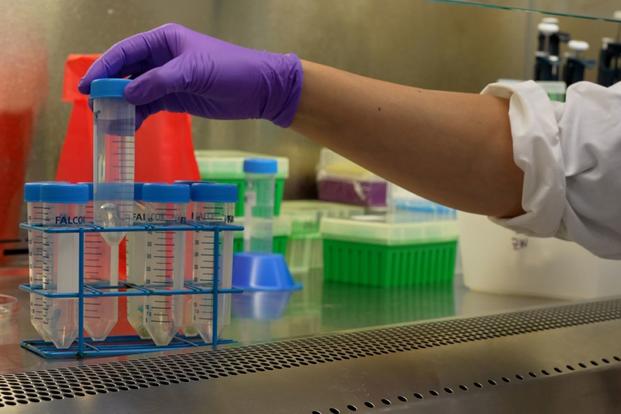On December 11, the Orion capsule splashed down in the Pacific, ending the historic Artemis I 25-day trip around the moon and back. There were no humans inside the capsule, but something was alive: vials containing several strains of Aspergillus Niger, a common household fungus that may contain the key to making humans resistant to toxic radiation. The samples, prepared for launch by the Naval Research Laboratory (NRL), are the first biological experiment from anywhere in the Defense Department to be launched into space.
Dr. Zheng Wang, a research biologist at NRL, told Sandboxx News that getting to the point of launching the fungus as part of the Artemis I mission took a decade of planning and study. It all began with a discovery at Chernobyl, the site of the devastating 1986 nuclear plant meltdown in what was then the Soviet Union. Tens of thousands of people were evacuated from the city of Pripyat, where the Chernobyl plant was located. Decades later the city remains a ghost town, unfit for residence due to dangerous levels of residual radiation.
But while humans no longer live by Chernobyl, one living thing has continued to flourish: Aspergillus Niger.
There where everything else fails
“Melanized fungi actually seem to thrive in environments with high levels of ionizing radiation (ultraviolet, X, and gamma rays), which is usually seen as very dangerous to life,” according to a 2016 post on the Earthling Nature blog.
“The walls of the damaged nuclear reactor of Chernobyl are covered in melanized fungi and they also are found living very [happily] on board of the International Space Station. Experiments showed that these melanized species of fungi seem to benefit from radiation, increasing their growth and germination,” the post continued.
Yes – this strange fungus has already been found in space and in every other known human environment. It’s the foundation for black mold, best known for growing in dark, damp spaces and making people sick, although the fungus itself is benign. So now the NRL wants to figure out what makes this organism tick: what makes it so resilient to conditions that harm humans, and how it changes or responds when sent to space.
Related: Project Horizon: Nukes and shotguns on the moon

Space fungi to the service of humanity
The radiation found at a site like Chernobyl is fundamentally different from the radiation in space, though both pose risks to humans.
Practically, the only way to run experiments with space radiation is to get there. The Artemis I mission created an especially unique opportunity. As the first step in a multi-year NASA endeavor to return humans to the moon for the first time since 1972, Artemis went deep enough into space to conduct two lunar flybys, sandwiching six says in “distant retrograde orbit” on the far side of the moon. This is significant, according to NRL, because moon missions experience twice as much radiation exposure as the International Space Station, which is in low earth orbit.
Wang said the research made sense for the Navy for two reasons: first, modern warfare entails the possibility of an attack that could result in nuclear fallout, harmful radiation that can kill people in high enough doses and severely sicken them in lower ones. Second, the Navy wants to develop spacecraft for various purposes, including communications, and one way to make them more resilient in space may be to leverage the protective properties of fungus. Better protection will expand the potential for both humans and spacecraft to explore the far reaches of space.
“So now we’re gonna use these fungi to produce this kind of biomaterial, to make a coating to protect spacecraft, and also put it in a coat [or protective garment] to protect human beings,” Dr. Wang told Sandboxx News. “This is one of the applications that we are very interested in.”

According to NRL officials, four different strains of fungus went to space onboard Orion: one wild strain, and three genetically mutated ones, engineered in the lab. Since the secret sauce of Aspergillus Niger appears to be its melanin – the darker it is, the better it appears to survive in irradiated environments – one strain has been made melanin-deficient. Two others have been made deficient in DNA repair mechanisms.
“Looking at the impact of melanin and DNA repair pathways in the samples with the effects of both cosmic radiation and microgravity will increase our knowledge for how humans may be impacted at the Moon and beyond as we continue to explore further,” Wang said in a released statement.
Observing how the fungus responds to space exposure may have implications for medicine, too: Wang said it is possible the samples could create new molecules as they adapt to space conditions that could be isolated and used to create new treatments or therapies.
From the moon to Antarctica
Now that the Artemis I samples are back within the surly bonds of earth, they’ll return to NRL for extensive study and testing. But the experiments are not over yet. Wang said another set of samples will make a trip to the International Space Station in March onboard a SpaceX rocket. And sometime in 2024, Aspergillus Niger samples will head to another extremely harsh environment: Antarctica. At the bottom of the world, scientists will be able to see how the fungus fares in extreme cold and at great terrestrial altitude. In the coming year, NRL scientists will also be drawing up plans on how to move forward with the data the recently completed experiment generates.
While this Artemis I experiment is the first of its kind for the military, Wang suggested that the new and growing U.S. Space Force could create more opportunities for these kinds of space experiments within the Defense Department.
“If more opportunities arise,” Dr. Wang told Sandboxx News, “we’re ready to go.”
Read the original article on Sandboxx.












